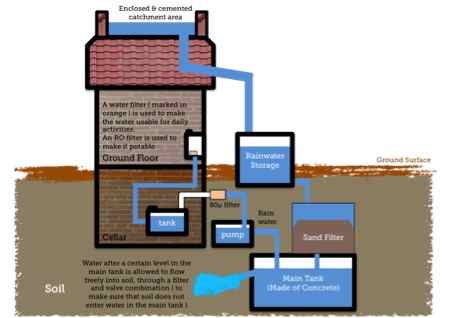 Installing a Rainwater Harvesting System (RHS) could be a major step in achieving your ideal, eco-friendly home. You could be collecting your own water through the beauty of nature rather than seeing the bills pile up on the doormat from the Utility Company. By installing a run-off system from your roof that leads to a storage area, pumps and purifiers, rainwater can be used across your home.
Installing a Rainwater Harvesting System (RHS) could be a major step in achieving your ideal, eco-friendly home. You could be collecting your own water through the beauty of nature rather than seeing the bills pile up on the doormat from the Utility Company. By installing a run-off system from your roof that leads to a storage area, pumps and purifiers, rainwater can be used across your home.
Even if you are already connected to the water supply, there are advantages to harvesting rainwater. If you are on a meter, your water bill will be reduced as the collected water can be put to use for non-drinking purposes such as showers, baths, flushing toilets, washing dishes. Drinking water is not easily renewable and if you wish to use your collected water for things that don’t require purification, harvesting is cost effective and requires little maintenance. It is also beneficial in terms of reducing wastage.
If you are cultivating your own crops and living off your plot of land, the collected water can be funnelled into an irrigation system. On an environmental level, the collection of rainwater will vastly improve the levels of groundwater. With a rise in population, groundwater levels have decreased and therefore increased the strife in parts of the world where water is scarce. Rainwater harvesting also reduces the level of surface water and lessens the chance of flooding, soil erosion and river contamination brought about by rainwater running through pesticides and other agricultural chemicals.
The disadvantages of rainwater harvesting are two-fold. Firstly, the initial cost of installing a storage system, purification methods and pumping can, according to YouGen, cost between $3000-$5000 (£2000-£3000 )and then running the pump will cost 5-10c a week. However you can now have your RHS plumbed straight into your existing piping and according to the Rainwater Harvesting Association can reduce your water consumption by as much as 40%. The use of a cistern to obtain drinking water in a city can be a tricky business. Shingled roofs, rather than clay or metal are less clean and liable to allow pollution to seep into the water. A pre-filtering system would have to be set up on the shingled roof prior to deposition in the tank to achieve drinkable water.
With water remaining in storage for a considerable degree of time, it is prone to stagnation, algal blooms and rodents spreading water-borne disease. Your harvesting system therefore has to be regularly maintained. Then of course, you are at the mercy of the clouds. Rainfall can be unpredictable and your levels of water will be affected by your geographical location.
The legal and red tape processes one has go through in order to begin to harvest your own water vary wildly. In 2012 a RHS case went viral when 64 year old Gary Harrington from Oregon was sentenced to 30 days in prison for illegal collection of rainwater https://www.truthorfiction.com/collecting-rainwater-is-illegal-in-some-states/. Oregon Water Resources Department stated that Harrington had dammed up artificial water channels across his property without obtaining the correct water permit. The amount of water he collected had the potential to fill 20 Olympic size swimming pools.
Confusion lies when public water, which includes rainwater, is not obtained from an artificial run-off such as a roof or car park. Set outlines have to be adhered to when collecting rainwater in this manner and a tax credit system has been set up in the USA for those investing in RHS https://www.enlight-inc.com/blog/?p=1036#californias.
Laws differ by state in the US concerning the harvesting of rainwater. For example in Texas RHS is encouraged by the state government and Texas even has a state law that clearly protects the right to harvest rain water called HB. 645. However in stark contrast to most states, Colorado still falls well short in terms of being eco-minded. It still remains illegal to harvest rainwater. Run-off from roofs will continue to pass through contaminated surfaces and flow into rivers and lakes. Oklahoma, Connecticut, Virginia and the majority of other states all encouraged harvesting and the use of rain barrels. For a complete and comprehensive list of the various laws in the respective US states see here: https://www.enlight-inc.com/blog/?p=1036.
At present in the UK, about 400 Rainwater Harvesting Systems are installed every year. Progress was made initially through the government’s use of the Code for Sustainable Homes. The cost of achieving a Level 1 home was relatively inexpensive. Use of compost and recycling bins achieved Level 1 status. However, building to Level 3 could cost up to £3000 with an additional £2000 code assessment for even a small build. Oddly, a zero-carbon home could only achieve Level 1 and groups such as The Construction Products Association and the Sustainable Development Commission critiqued the Code and called for its redesign. In March 2015 the Code was withdrawn for further developments https://www.gov.uk/government/speeches/planning-update-march-2015.
The government needs to start putting eco-friendly homes higher up on their agenda if we want to see Rainwater Harvesting Systems being employed more and more in new builds.
Further details on the process of harvesting water and sewage can be found here:
https://science.howstuffworks.com/environmental/green-science/living-off-the-grid2.htm.
One Response
I read the above article and got some knowledge from your article which is about Why do we want rainwater harvesting It’s actually great and useful data for us. Thanks for sharing it.